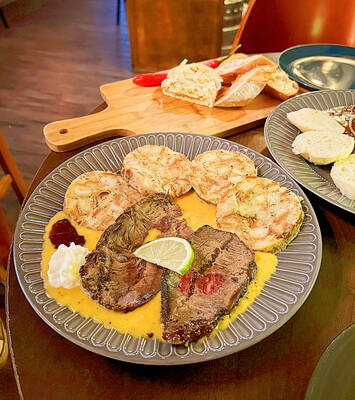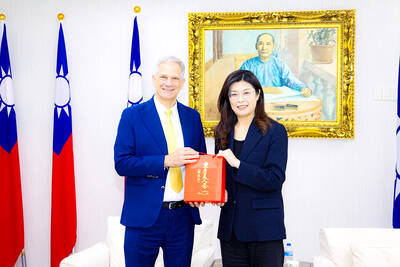A child zips into Room 103 of the Museum of Contemporary Art (MOCA, 台北當代藝術館), completely oblivious of the sign reading “high voltage,” and lunges at Scottie Huang Chih-chih’s (黃致傑) Motivational Sense Organism (動覺生物), an installation that uses lights and plastic flowers fused to small latticed booms with faux fern leaves, which elevate when a museumgoer approaches. After a scolding from a museum employee, the boy slowly reaches his hand out towards one of the fronds in an attempt to manipulate the sensors inside. The leaf moves but the boy loses interest and darts out, causing the frond to slump. The process is repeated as other children, parents in tow, enter the gallery.
Huang’s piece is part of the 3rd Digital Art Festival Taipei 2008, a collection of more than 40 interactive installations, Internet artworks, computer animations and digital games that runs until Nov. 9. The festival’s title, - Trans -, which is short for “transcending space and time,” seems somewhat misleading, because many of the works on display focus on the interaction between people and art. In this exhibit, humans take the place of interfaces such as keyboards that are used to manipulate machines and input data. In other words, the nifty gizmos-cum-art seek to make the viewer an active participant, rather than a passive viewer.
Some of the interactive installations use the bodies of museumgoers to create light, movement or sound, or a combination of all three. South Korean artist Mok Jin-yo’s sound-and-light installation, SoniColumn, can be played by touch. Like pressing the keys of a piano, passing one’s hand over one of the piece’s hundreds of LED light nodes causes a sound to be emitted.
Sixteen tubes hang from the gallery’s ceiling for Southern Wave 2: Concealment Space, a joint creation by Tainan University of the Arts Music Department and Logico-Studio (朗機工). Inside the tubes are spinning columns, each of which contains nodes of light bulbs. Speaking or singing into a microphone activates a sensor, creating a symphony of light. On a visit last Sunday, one woman broke into song, as if she were in a KTV, drawing cheers from a crowd of spectators.
Although many of the computer programs in the festival seem more like resume fodder for young engineers and artists (Single Cylinder, for example, looks like your average motorcycle racing video game, though it uses brands of scooters found in Taiwan), some come with a message, such as Regenerator, a video game that draws children’s attention to problems of environmental destruction, war and disease.
Many of the videos and animations require more of an attention span to digest. Chu Shu-shyan’s (朱書賢) four-minute animated video Dark Seed. Sprouting (黑色種子.抽芽) is a masterpiece of understatement, with a young man and a vagabond sitting on a bench, each smoking a cigarette. The minimalist narrative structure evokes Samuel Beckett’s later works and, somewhat paradoxically, its digital images are reminiscent of Grand Theft Auto. I watched the short three times; each viewing revealed something completely different, like a text that can be read and reread for different layers of meaning. Chu’s piece is located in a room with five other digitally generated shorts, which range from four to eight minutes in length and are all worthy of viewing. The museum has provided benches from which to watch the shorts.
Walking into MOCA this past Sunday afternoon, I was shocked to encounter something I’d never seen before at the museum: a long line. It was comprised overwhelmingly of families and young couples, who waited as long as half an hour to enter the museum so they could ponder, examine, watch and fiddle with the installations, videos and other art on display. Though some might find a deeper meaning underlying these ultra-modern gadgets, it seems that, above all, they are meant to be played with, rather than admired or contemplated. Traditionalists may scoff at the concept, but the kids seem to love it.

Seven hundred job applications. One interview. Marco Mascaro arrived in Taiwan last year with a PhD in engineering physics and years of experience at a European research center. He thought his Gold Card would guarantee him a foothold in Taiwan’s job market. “It’s marketed as if Taiwan really needs you,” the 33-year-old Italian says. “The reality is that companies here don’t really need us.” The Employment Gold Card was designed to fix Taiwan’s labor shortage by offering foreign professionals a combined resident visa and open work permit valid for three years. But for many, like Mascaro, the welcome mat ends at the door. A

If China attacks, will Taiwanese be willing to fight? Analysts of certain types obsess over questions like this, especially military analysts and those with an ax to grind as to whether Taiwan is worth defending, or should be cut loose to appease Beijing. Fellow columnist Michael Turton in “Notes from Central Taiwan: Willing to fight for the homeland” (Nov. 6, page 12) provides a superb analysis of this topic, how it is used and manipulated to political ends and what the underlying data shows. The problem is that most analysis is centered around polling data, which as Turton observes, “many of these

Divadlo feels like your warm neighborhood slice of home — even if you’ve only ever spent a few days in Prague, like myself. A projector is screening retro animations by Czech director Karel Zeman, the shelves are lined with books and vinyl, and the owner will sit with you to share stories over a glass of pear brandy. The food is also fantastic, not just a new cultural experience but filled with nostalgia, recipes from home and laden with soul-warming carbs, perfect as the weather turns chilly. A Prague native, Kaio Picha has been in Taipei for 13 years and

Since Cheng Li-wun (鄭麗文) was elected Chinese Nationalist Party (KMT) chair on Oct. 18, she has become a polarizing figure. Her supporters see her as a firebrand critic of the ruling Democratic Progressive Party (DPP), while others, including some in her own party, have charged that she is Chinese President Xi Jinping’s (習近平) preferred candidate and that her election was possibly supported by the Chinese Communist Party’s (CPP) unit for political warfare and international influence, the “united front.” Indeed, Xi quickly congratulated Cheng upon her election. The 55-year-old former lawmaker and ex-talk show host, who was sworn in on Nov.